|
Spanish GreenWays Programme
Vías Verdes / Greenways are the result of converting
disused railway lines into cycling and walking routes. Easy,
accessible, far removed from motorised traffic and with
hardly any steep slopes, they are specially recommended for
nature lovers and people who enjoy outdoor exercise.
There are already 7.600 kilometres of disused railway
lines throughout Spain (more than 135 greenways), all of
which have been carefully prepared to allow you to discover
the most hidden corners of our countryside.
The Greenways allow their use by all types of users: elderly
people, children and even disabled people. A different way
to travel along a special country with extraordinary scenery
and culture: amazing valleys and mountains, impressive
bridges and viaducts more than a hundred years old,
mysterious tunnels that once let the trains pass through and
now await the new adventurers.
There is basic information about all Vías Verdes and if you
want to have further info with more detailed information of
some Vías Verdes you can see at "Travel
Guides".
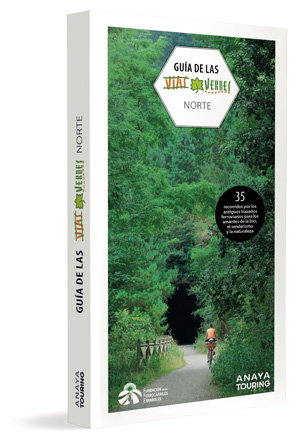 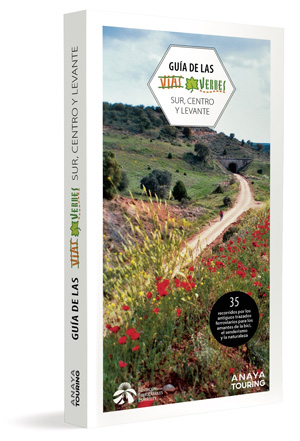 Also,
there are 2 volumes of “Guía de Vías Verdes” (see “Publicaciones”)
where you can find more than 3,000 km of itineraries along
abandoned railways in Spain (all of them available for
cyclists) specifically conditioned and signalled. This
publication is available only in Spanish, but it includes
maps, pictures and useful information for accommodation,
railways connections, etc., and these Guides are only
available in Spain in specific bookstores or in online
bookstores. Also,
there are 2 volumes of “Guía de Vías Verdes” (see “Publicaciones”)
where you can find more than 3,000 km of itineraries along
abandoned railways in Spain (all of them available for
cyclists) specifically conditioned and signalled. This
publication is available only in Spanish, but it includes
maps, pictures and useful information for accommodation,
railways connections, etc., and these Guides are only
available in Spain in specific bookstores or in online
bookstores.
The Official Road Map published in Spain by The Ministry
of Transport includes also the Greenways / “Vías Verdes”.
The Vías Verdes are marked in green (with pictograms of
cyclist, walker or horseman) explaining that these are
routes for non-motorised users.
Information and order: Publications Department of Ministry
of Public Works and Transport:
https://www.mitma.gob.es/carreteras/usuarios/mapa-oficial-de-carreteras or directly in bookstores.
 The
Vías Verdes (Greenways) Programme was launched in Spain in
1993 with the aim to develop itineraries for non-motorised
transport using disused railway lines. Since it started, the
Vías Verdes Programme has been the fruit of close
co-operation between the various public sector bodies (local
and regional level), including the railway companies as well
as various citizen groups and associations. The
Vías Verdes (Greenways) Programme was launched in Spain in
1993 with the aim to develop itineraries for non-motorised
transport using disused railway lines. Since it started, the
Vías Verdes Programme has been the fruit of close
co-operation between the various public sector bodies (local
and regional level), including the railway companies as well
as various citizen groups and associations.
The Vías Verdes Programme started in 1993, when the
former Minister for Public Works, Transport and Environment
(MOPTMA), together with the two State Railway companies
(ADIF, RENFE Operadora and FEVE) commissioned the Spanish
Railway Foundation (F.F.E.) the elaboration of a National
Inventory of disused railway lines. This research also
permitted a preliminary contact with around 1.000 local
authorities.
The inventory (with an overall budget amounting to 60,000
Euro) resulted in 98 railway lines, managed by the three
public authorities that commissioned the inventory, which
represented a total of 5.764 kilometres, including 954
stations. In addition, this inventory collected basic
information about 89 former mining and industrial private
railway lines which amounted to 1.920 kilometres. As a
result, in 1993 there were in Spain around 7,600 kilometres
of abandoned railway lines.
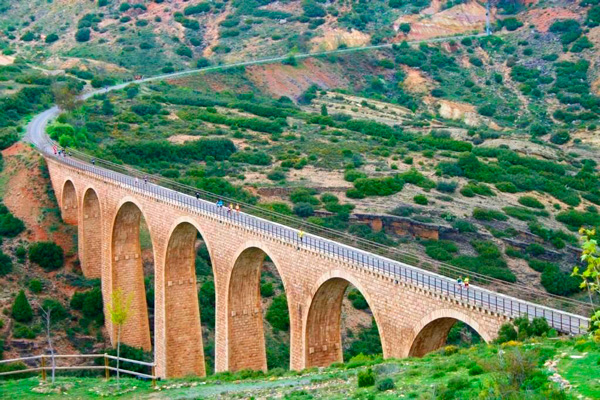 The
Vías Verdes Programme is the result of a cooperation
agreement between Agriculture, Fishing and Food Ministry,
which committed itself to set aside a sum of budget for
Greenways construction, and Adif, who contributed with their
abandoned lines and stations, as well as FFE which was given
the responsibility for promoting, co-ordinating and
informing on the programme nation-wide. The political and
social support received by the Spanish Vías Verdes
Programme, as well as the promotion made by the media, has
been very significant. In June 2001, the National Parliament
(Senado) unanimously voted a motion, encouraging the Spanish
Government to improve the necessary tools and laws in order
to convert all the disused railway lines around the country
into Vías Verdes. The
Vías Verdes Programme is the result of a cooperation
agreement between Agriculture, Fishing and Food Ministry,
which committed itself to set aside a sum of budget for
Greenways construction, and Adif, who contributed with their
abandoned lines and stations, as well as FFE which was given
the responsibility for promoting, co-ordinating and
informing on the programme nation-wide. The political and
social support received by the Spanish Vías Verdes
Programme, as well as the promotion made by the media, has
been very significant. In June 2001, the National Parliament
(Senado) unanimously voted a motion, encouraging the Spanish
Government to improve the necessary tools and laws in order
to convert all the disused railway lines around the country
into Vías Verdes.
In 1998, the European Greenways Association
was established in Namur with the aim to promote and inform
about anything related to the creation of Greenways on a
European level, and FFE was elected for the EGWA Presidency.
The greatest international reward for the Spanish Vias
Verdes Programme took place in October 2000, when the FFE
received the United Nations Best Practices Habitat
International Award. This award encouraged the FFE to
organise more international initiatives with the purpose of
spreading the Spanish experience as a practical reference
for some other countries, specially Portugal and Latin
American nations; in July of 2002 FFE organised the First
International Conference about Vías Verdes in Latin America
in collaboration with the United Nations and the Spanish
Government.
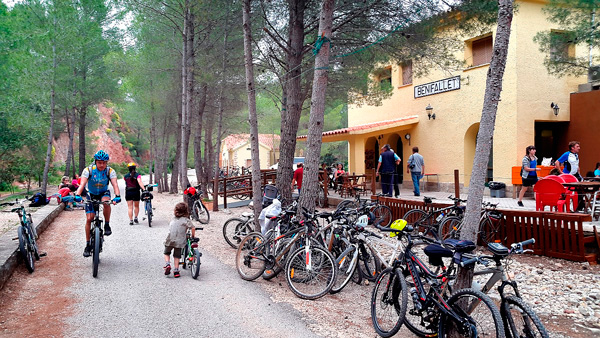 In
2023, 30 years after its launching, the balance of the
Programme in Spain has been very positive. More than 260
Million Euros have been invested in converting some 3.300
kilometres of disused railway line into 135 Vías Verdes,
and there are in addition 350 new kilometres whose technical
project is already finished. In
2023, 30 years after its launching, the balance of the
Programme in Spain has been very positive. More than 260
Million Euros have been invested in converting some 3.300
kilometres of disused railway line into 135 Vías Verdes,
and there are in addition 350 new kilometres whose technical
project is already finished.
From 1994 onwards, the new Ministry for the Environment
has financed the Programme under the “Programa de Caminos
Naturales (Natural paths Programme)” together with several
regional and local authorities. In addition to this
investment, is the cost of rehabilitating buildings that
will be used for the installation of equipment and
complementary services (in many cases, this kind of
investment is higher than the cost of constructing the
itinerary of the Via Verde).
Nowadays, there are 125 rail old station rehabilitated as
restaurants, cafés, hotels, museums, information points,
rent-a-bike services or even swimming pools.
The procedure is as follows. The local and/or regional
authorities concerned draw up the “Vía Verde Viability
Plan”, with the co-operation (if requested) of the FFE: the
ownership status of the land is analysed and a design for
the rehabilitation of the railway line into a future
Greenway is defined in agreement with local authorities and
associations. At this stage, a commitment for the management
and maintenance of the Greenway is laid down, either via the
local councils, or their communities, provincial or regional
governments, or through consortia, companies or foundations
set up for this specific purpose.
Once the viability study has been completed, the measures
agreed are incorporated into the construction plan, whose
undertaking may be financed in one of three different ways,
namely: entirely from Ministry budgets, or other regional or
local authorities (a formula which is gaining ground), or
via a specific finance project adapted to the regional or
local conditions.
Economic impacts: leisure and tourism
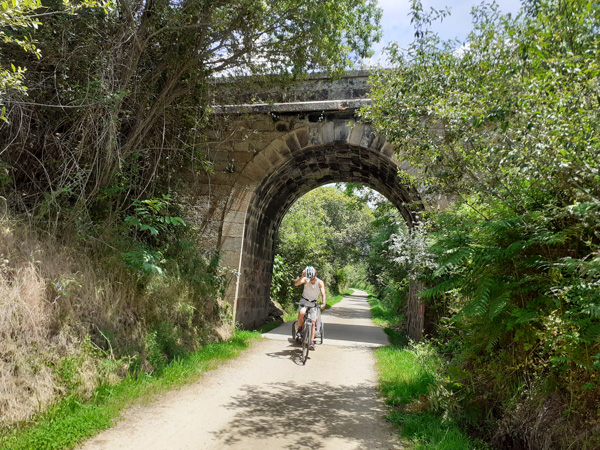 The
Greenways constitute a novel and attractive resource for
active tourism in Spain. Ecological and responsible tourism
has become the most appropriate complement and alternative
for the traditional beach and sun offer. In such a rugged
geographical landscape as Spain's, the Vías Verdes acquire
additional qualities, since more than 500 tunnels and 1,100
viaducts and bridges assure continuity and universal
accessibility. The
Greenways constitute a novel and attractive resource for
active tourism in Spain. Ecological and responsible tourism
has become the most appropriate complement and alternative
for the traditional beach and sun offer. In such a rugged
geographical landscape as Spain's, the Vías Verdes acquire
additional qualities, since more than 500 tunnels and 1,100
viaducts and bridges assure continuity and universal
accessibility.
Some Greenways already have had a favourable effect on
the redistribution of mass tourism: the Carrilet Vía Verde
which cross a volcanic region in the foothills of the
Pyrenees, arriving to the ancient city of Girona, and
running into the Costa Brava. Already it received nearly 1
million visitors/year, half of whom come from other regions,
particularly the Barcelona metropolitan area. The success of
this route has been such, that it has encouraged local
business people, hotels and restaurants owners' to request
authorisation to place advertisements for their
establishments along the path.
 Furthermore,
the positive effect of the Greenways on the areas they pass
through is not limited to the tourist sector, but produce
other very different dynamic effects on the local population
and economy right from the beginning of its construction.
These effects are more significant if depressed rural areas
are considered, as in the case of the Sierra Greemway (36 km
already constructed). Here, thanks to the School- Workshop
training and employment programmes, groups of 60 unemployed
young people from local areas have been employed for two
years to rehabilitate four former stations along the
Greenways and to install tourist facilities on them.
Therefore, the structural renovation of these buildings
alone has meant considerable public investment. In 2023
several stations (Olvera, Coripe, Zaframagón and Puerto
Serrano) has been turned into rural hotels with restaurant,
rural accommodation, museums, etc; the inside installations
have been paid with private investment. Others station as
Coripe or Zaframagon are today a new hotel and a bird
watching museum. So far, the Sierra Vía Verde has permit to
create 29 new jobs, and it's visited by 300.000 tourists-per
year. Furthermore,
the positive effect of the Greenways on the areas they pass
through is not limited to the tourist sector, but produce
other very different dynamic effects on the local population
and economy right from the beginning of its construction.
These effects are more significant if depressed rural areas
are considered, as in the case of the Sierra Greemway (36 km
already constructed). Here, thanks to the School- Workshop
training and employment programmes, groups of 60 unemployed
young people from local areas have been employed for two
years to rehabilitate four former stations along the
Greenways and to install tourist facilities on them.
Therefore, the structural renovation of these buildings
alone has meant considerable public investment. In 2023
several stations (Olvera, Coripe, Zaframagón and Puerto
Serrano) has been turned into rural hotels with restaurant,
rural accommodation, museums, etc; the inside installations
have been paid with private investment. Others station as
Coripe or Zaframagon are today a new hotel and a bird
watching museum. So far, the Sierra Vía Verde has permit to
create 29 new jobs, and it's visited by 300.000 tourists-per
year.
Promotion and dissemination
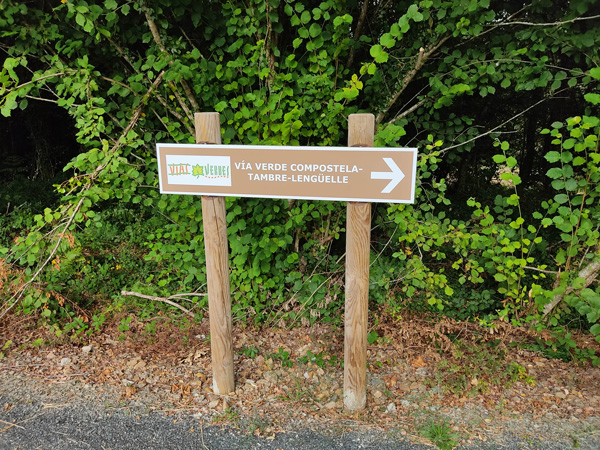 The
Spanish Vías Verdes Programme is intended to stimulate the
use of non-motorised means of transport, but that changes in
mentality will only be achieved if proper infrastructure
schemes are accompanied by training and information
measures. One example of promotional activities originated
in Spain which could spread to other European countries is
the organisation of the National Vías Verdes Day. From 1999
onward, each second Sunday on May, the different consortia
of Vías Verdes celebrate popular and festive activities, in
collaboration with the citizen associations and co-ordinated
by the FFE. Especially children, elderly and disabled people
are encouraged to walk and cycle along the Vías Verdes, as
well as politicians, professional cyclists, etc. This event
is certainly very successful and is widely publicised in the
media. (6.000 participants each year confirm the successful
or these activity). The
Spanish Vías Verdes Programme is intended to stimulate the
use of non-motorised means of transport, but that changes in
mentality will only be achieved if proper infrastructure
schemes are accompanied by training and information
measures. One example of promotional activities originated
in Spain which could spread to other European countries is
the organisation of the National Vías Verdes Day. From 1999
onward, each second Sunday on May, the different consortia
of Vías Verdes celebrate popular and festive activities, in
collaboration with the citizen associations and co-ordinated
by the FFE. Especially children, elderly and disabled people
are encouraged to walk and cycle along the Vías Verdes, as
well as politicians, professional cyclists, etc. This event
is certainly very successful and is widely publicised in the
media. (6.000 participants each year confirm the successful
or these activity).
One of the characteristics which defines the Spanish Vías
Verdes, and which gives them a special quality, is the
existence of a Spanish Greenways Programme National
Programme which provide homogenous signs of identity
in each and every Vía Verde, which uses an identifying logo
and a common denomination: “Vía Verde”. Evenly the
signposting was specifically and uniformly designed for
being used on the different Vías Verdes. In the past old
wooden railway sleepers was used as signpost supports and as
kilometre markers, and they are also used as obstacles to
prevent motorised traffic to enter the green way, and
particularly at road junctions.
This quality brand is one of the programme's greatest
triumphs and contributes without any doubt to its promotion.
A vital aspect, in this respect, has been the publication of
a Vías Verdes Guide from 1997, the web site (www.viasverdes.com).
This web site has 3 millions of pages visited/year; Apps on
iOs or
Android, leaflets, publications, videos…. So you can
also follow us
on
Facebook,
Twitter,
Instagram or
YouTube

Download the leaflet (English) >>
Further info (on Spanish):
www.viasverdes.com
Come and enjoy a different
way
to travel along a special country !!!
|
